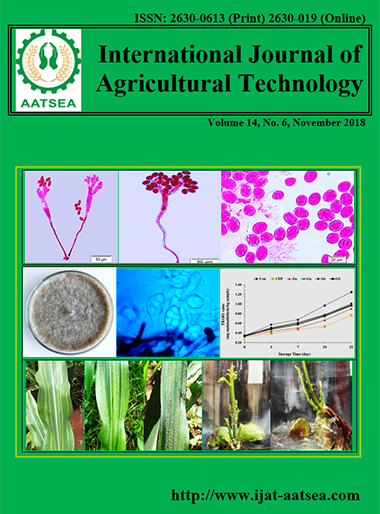Biosynthesis of Zinc Nanoparticles and Its Effect on Enzymes Production by Bacillus subtilis and Pseudomonus flourescens Using Different Agricultural Wastes
Main Article Content
Abstract
Biological synthesis of zinc nanoparticles is an environmental eco-friendly. Bacillus subtilis and Pseudomonas fluorescens which has been isolated from healthy beans plants and identified in plant pathology department at (NRC) were used for production of pectinase and chitinase enzymes in media containing different agriculture wastes and zinc nitrate to initiate nanoparticles synthesis. Pomegranate peel and Colocasia peel were the most promising wastes in zinc nanoparticles synthesis 100, 200 nm as proven by Transmission electron microscopy (TEM) and UV visible spectral analysis. The effectiveness of different agricultural wastes on the linear growth of green bean root rot fungi in vitro was investigated. Also, Pomegranate peel and Colocasia peel were the most effective on reducing linear growth of all pathogens. And enzymes activity from two bacterial strains was used different agricultural wastes as substrate and its antagonistic effects on pathogenic fungi.
Article Details

This work is licensed under a Creative Commons Attribution-NonCommercial-NoDerivatives 4.0 International License.
References
Abdallah, M. E., Abdullah, Al-R, Shaban, R. S., Abdurahman, H., Ashraf, A. M. and Ali, H. B. (2016). Antimicrobial activity and green synthesis of silver nanoparticles using Trichodermaviride. Biotechnology and Biotechnological Equipment. 30:299-304.
Aliaa, E. M., Atef, A. H., Manal, A. H., Mahmoud, El. H. and Mohamed, R. (2015). Effect of metal nanoparticles on the growth of ochratoxigenic molds and ochratoxin a production isolated from food and feed. International Journal of Research Studies in Biosciences. 3:1-14.
Barnett, H. L. and Hunter, B. B. (1972). Illustrated genera ofimperfect fungi. 3rd edition, Burgess Publishing Co. pp. 273.
Bhattacharya, D., and Rajinder, G. (2005). Nanotechnology and potential of microorganisms. Critical Reviews in Biotechnology. 25:199-204.
El-Rafiea, M. H., Shaheena, T. I., Mohamedb, A. A., Hebeish, A. (2012). Bio-synthesis and applications of silver nanoparticles onto cotton fabrics Carbohydrate Polymers. 90:915- 920.
El-Mohamedy, R. S. R., Shafeek, M. R. and Fatma, A. R. (2015). Management of root rot diseases and improvement growth and yield of green bean plants using plant resistance inducers and biological seed treatments. Journal of Agricultural Technology. 11:1219-1234.
El-Mohamedy, R. S. R., Shafeek, M. R., Abd El-Samad, E. H., Salama, D. M. and Rizk, F. A. (2017). Field application of plant resistance inducers (PRIs) to control important root rot diseases and improvement growth and yield of green bean (Phaseolus vulgaris L.) Australian journal of crop science. 11:496-505.
Fouda, A., EL-Din, S. H., Salem, S. S. and Shaheen, T. I. (2018). In-Vitro cytotoxicity, antibacterial, and UV protection properties of the biosynthesized Zinc oxide nanoparticles for medical textile applications. Microbial Pathogenesis. 125:252-261.
Gruère, G., Narrod, C. and Abbott, L. (2011). Agriculture, Food, and Water Nanotechnologies for the Poor: Opportunities and Constraints.
Kanan, B., Narayanan and Sakthivel, N. (2010). Biological synthesis of metal nanoparticles by microbes. Advances in Colloid and Interface Science. 156:1-14.
Khabat Vahabi, G. (2011). Biosynthesis of Silver Nanoparticles by Fungus Trichoderma reesei (A Route for Large-Scale Production of AgNPs). 1:65-79. doi:10.5640/insc.010165 ISSN 1664-171X.
Kolodziejczak-Radzimska, A. and Jesionowski, T. (2014). Zinc Oxide-From Synthesis to Application. Materials. 7:2833-2881.
Mandal, D., Bolander, M. E., Mukhopadhyay, D., Sarkar, G. and Mukherjee, P. (2006). The use of microorganisms for the formation of metal nanoparticles and their application. Applied Microbial Biotechnology. 69:485-492.
Mansoori, G. A. (2005). Principles of nanotechnology – molecular-based study of condensed matter in small systems, World Scientific Publishing, Hackensack, NJ2005.
Miller, G. L. (1959). Use of dinitrosalicylic acid reagent for determination of reducing sugar. Analaytical Chemistry. 31:426-428.
Monreal, J. and Reese, E. T. (1969). The chitinase of Serratia marcescens. Canadian Journal of Microbiology.15:689-696.
Nelson, P. E., Toussoun, T. A. and Marasas, W. F. O. (1983). USA: Pennsylvania University Press. pp.193.
Nema, N., Alamir, L. and Mohammad, M. (2015). Production of cellulase from Bacillus cereus by submerged fermentation using corn husks as substratesInternational Food Research Journal. 22:1831-1836.
Policy Brief 19. Washington, D. C. (2014). International Food Policy Research Institute;2011. Availablefromhttp://www.ifpri.org/sites/default/files/publications/bp019.pdf.Accessed May 6, 2014.
Chaturvedi, S., Singh, R. and Khurana, P. S. M. (2015). Production of Bacterial - Xylanolytic Enzyme using Agricultural Waste by Solid State Fermentation International Journal of Current Microbiology and Applied Sciences. 4:9-16.
Sastry, M., Ahmad, A., Islam Khan, M. and Kumar, R. (2003). Biosynthesis of metal nanoparticles using fungi and actinomycete. Current Science. 85:162-170.
Shamy and Sherien, M. M. Atalla (2015). Production and Optmization of Invertase FromPomegranate Peel by Marine Fungal Strain Aspergillus terrusGlobal Advanced Research Journal of Microbiology. 4:130-139.
Sonkaria, S., Ahn, S. H. and Khare, V. (2012). Nanotechnology and its impact on food and nutrition: a review. Recent Pat Food Nutr Agric. 4:8-18.
Snedecor, G. W. and Cochran, W. G. (1982). Statistical methods. 7th Ed. Iowa State Univ. Press Ames. Iowa, USA.
Vennila, S., Jesurani, S. S. (2017). Eco-friendly green synthesis and characterization of stable ZnO Nanoparticle using small Gooseberry fruits extracts. International Journal of ChemTech Research. 10:5.


